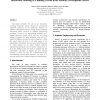ICSE
2003
IEEE-ACM
15 years 16 days ago
2003
IEEE-ACM
Software development organisations are paying more and more attention to the usability of their software products. To raise the usability level of the software product, it is nece...
ICSE
2003
IEEE-ACM
15 years 16 days ago
2003
IEEE-ACM
This paper argues for a model-driven framework for integrating human interface engineering with software engineering. The usage-centered design process, a robust and proven proces...
ICSE
2003
IEEE-ACM
15 years 16 days ago
2003
IEEE-ACM
The lack of a common language and mutual understanding between the disciplines of systems development/software engineering and HCI does create challenges for both teaching and pra...
ICSE
2003
IEEE-ACM
15 years 16 days ago
2003
IEEE-ACM
In this paper we discuss an approach for simulating the behaviour of interactive software systems, before starting on any of the actual implementation, based on a model of the sys...
ICSE
2003
IEEE-ACM
15 years 16 days ago
2003
IEEE-ACM
Methods to assess and ensure system usability are becoming increasingly important as market edge becomes less dependent on function and more dependent on ease of use, and as recog...
ICSE
2003
IEEE-ACM
15 years 16 days ago
2003
IEEE-ACM
This paper proposes the use of an interaction modeling language called MoLIC to graphically represent scenarios as an additional resource in software development. MoLIC brings hum...
ICSE
2003
IEEE-ACM
15 years 16 days ago
2003
IEEE-ACM
Dynamic slicing algorithms can greatly reduce the debugging effort by focusing the attention of the user on a relevant subset of program statements. In this paper we present the d...
ICSE
2003
IEEE-ACM
15 years 16 days ago
2003
IEEE-ACM
In our research demonstration, we show two development support systems for Java programs. One is an Aspectoriented Dynamic Analysis and Slice calculation system named ADAS, and an...
ICSE
2003
IEEE-ACM
15 years 16 days ago
2003
IEEE-ACM
Some "non-' or "extra-functional" features, such as reliability, security, and tracing, defy modularization mechanisms in programming languages. This makes suc...
ICSE
2003
IEEE-ACM
15 years 16 days ago
2003
IEEE-ACM
Recent evidences indicate that most faults in software systems are found in only a few of a system's components [1]. The early identification of these components allows an or...





